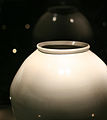- Joseon white porcelain
-
Joseon white porcelain 
Joseon white porcelain exhibited at National Museum of KoreaKorean name Hangul 조선백자 Hanja 朝鮮白磁 Revised Romanization Joseon baekja McCune–Reischauer Chosŏn paekcha Joseon white porcelain or Joseon baekja refers to the white porcelains produced during the Joseon dynasty (1392-1910).
Contents
History
White porcelains were preferred and praised than any other porcelains during the time to represent Korean Confucian ethics such as frugality and pragmatism.[1] In overall, Joseon ceramics undergone numerous transformations during the five hundred year period and is generally divided into three major periods; the early, the middle, and the late period. Although the chronology of Joseon ceramics differs between scholars, three major events affected kiln production; the outcome of the Imjin wars, the establishment of Bunwon (hangul: 분원; hanja: 分院), government-subsided kilns at Bunwon-ri, Gwangju near Seoul in 1751, and the privatization of Bunwon in 1884. Joseon white porcelains are characterized by the beauty of unpretentious forms, understated decoration, and subtle use of color, reflecting the ideals of Korean Confucian state.
Gallery
-
Moon jar at National Museum of Korea
-
Baekja cheonghak guimunho (백자청화학귀문호), late 18th century, Museum of Fine Arts, Boston[2]
See also
- Blue and white porcelain
- Celadon
- Korean pottery and porcelain
- Chinese ceramics
- Blanc-de-Chine
- Japanese pottery and porcelain
- Japanese invasions of Korea (1592–1598)
References
- ^ James Hoare; Susan Pares (1988). Korean, An Introduction. Routledge. p. 143 p. ISBN 0710302991. http://books.google.com/books?id=_zoOAAAAQAAJ&pg=PA144&lpg=PA143&dq=korea+ceramic+white&lr=&as_brr=3&sig=vSS25vADZ6sGnhfcRC2qF42mgfE. Retrieved 2008-03-29.
- ^ "White porcelain with underglaze cobalt-blue decoration (백자청화학귀문호, 白瓷靑畵鶴龜文壺)". Museum of Fine Arts, Boston. http://www.mfa.org/collections/search_art.asp?recview=true&id=19115&coll_keywords=korean+porcelain&coll_accession=&coll_name=&coll_artist=&coll_place=&coll_medium=&coll_culture=&coll_classification=&coll_credit=&coll_provenance=&coll_location=&coll_has_images=&coll_on_view=&coll_sort=0&coll_sort_order=0&coll_view=0&coll_package=0&coll_start=21. Retrieved 2008-03-27.
- Jae-yeol Kim (2003). Handbook of Korean Art (White Porcelain and Punch'ong Ware). Laurence King Publishing. ISBN 1856693597. http://books.google.com/books?as_isbn=1856693597.
- Yun, Yong-i; Regina Krahl (2005). Korean Art from the Gompertz and Other Collections in the Fitzwilliam Museum. Translated by Youngsook Pak, Roderick Whitfield. Cambridge University Press. ISBN 0521835925. http://books.google.com/books?q=0521835925.
- Keith Pratt; Richard Rutt, James Hoare (1999). Korea: A Historical and Cultural Dictionary. Routledge. ISBN 0700704647. http://books.google.com/books?q=0700704639.
- Goro Akaboshi; Heiichiro Nakamaru (1975). Five Centuries of Korean Ceramics (Pottery and Porcelain of the Yi Dynasty). Weatherhill. ISBN 0834815141.
- Claire Roberts; Michael Brand, Powerhouse Museum, Queensland Art Gallery (2000). Earth, Spirit, Fire: Korean Masterpieces of the Choson Dynasty. Queensland Art Gallery. ISBN 1863170804.
- Lee, Soyoung (October 2004). ""In Pursuit of White: Porcelain in the Chosôn Dynasty, 1392–1910 "". In Timeline of Art History. The Metropolitan Museum of Art, New York City. http://www.metmuseum.org/toah/hd/chpo/hd_chpo.htm. Retrieved 2008-03-27.
- "White porcelain (백자 白磁)" (in Korean). Empas/EncyKorea. http://100.empas.com/dicsearch/pentry.html?s=K&i=266434&v=43#T3. Retrieved 2008-03-27.
- "White porcelain (백자 白磁)" (in Korean). Empas/Encyclopedia Britannica. http://100.empas.com/dicsearch/pentry.html?s=B&i=144143&v=43. Retrieved 2008-03-27.
External links
- Gallery of Korean Pottery and Porcelain at Korean Overseas Culture and Information Service (KOIS)
Porcelain China Chinese porcelain · Chinese export porcelain · Chinese influences on Islamic pottery
Types: Proto-celadon (16th century BCE) · Celadon (1st century) · Yue (2nd century) · Jingdezhen (6th century) · Sancai (8th century) · Ding (10th century) · Qingbai (12th century) · Blue and white (14th century) · Blanc de Chine (14th century) · Kraak (16th century) · Swatow (16th century) · Kangxi (17th century) · Famille jaune, noire, rose, verte (17th century) · Tenkei (17th century) · Canton (18th century)Korea Types: Joseon (14th century)Japan Europe French porcelain · Chinese porcelain in European painting
Types: Fonthill Vase (1338) · Medici (1575) · Rouen (1673) · Nevers · Saint-Cloud (1693) · Meissen (1710) · Chantilly (1730) · Vincennes (1740) · Chelsea (1743) · Oranienbaum (1744) · Mennecy (1745) · Bow (1747) · Nymphenburg Porcelain Manufactory (1747) · Plymouth (1748) · Worcester (1751) · Frankenthal Porcelain Factory (1755) · Sèvres (1756) · Derby (1757) · Wedgwood (1759) · Wallendorf (1764) · Etiolles (1770) · Limoges (1771) · Clignancourt (1775) · Royal Copenhagen (1775) · Revol (1789) · Herend Porcelain Manufactory (1826) · Zsolnay (1853)Technologies People Ehrenfried Walther von Tschirnhaus · Johann Friedrich Böttger · Francois Xavier d'Entrecolles · Dmitry VinogradovCollections British Museum (London): Asia Department / Percival David Foundation · Dresden Porcelain Collection · Gardiner Museum (Toronto) · Kuskovo State Museum of Ceramics (Moscow) · Musée national de Céramique-Sèvres (Paris) · Musée des Arts Décoratifs (Paris) · Palace Museum (Beijing) · Topkapı Palace (Istanbul) · Victoria and Albert Museum (London) · Worcester Porcelain MuseumCategories:- Korean pottery
- Porcelain
-
Wikimedia Foundation. 2010.




